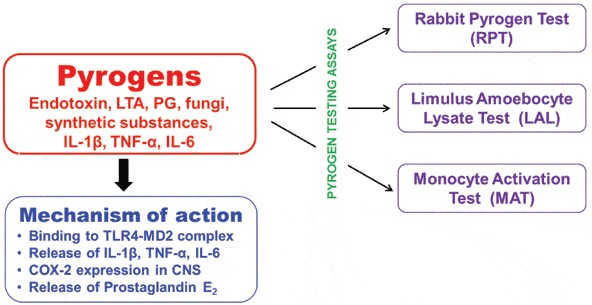Endotoxins and pyrogens are two terms that are frequently used to describe agents that can cause fever. While both are associated with high temperatures, there are important differences in the way they cause fever.
In this blog, we will discuss the differences between endotoxins and pyrogens, their sources, and the potential consequences of exposure.
Overview of endotoxin and pyrogen

Endotoxin and pyrogens are both substances found in the environment that cause fever, chills, and other symptoms. However, they are very different and have distinct characteristics.
Endotoxins are toxins released from the cell walls of certain bacteria, and they can cause a wide range of symptoms, from mild fever to life-threatening sepsis. Pyrogens, on the other hand, are not toxins, but rather proteins or other substances secreted by certain bacteria or viruses that cause fever. Pyrogens can also cause other symptoms such as chills, headaches, and nausea.
The key difference between the two is that endotoxins are toxins released by bacteria, while pyrogens are proteins secreted by bacteria or viruses.
Differences between endotoxin and pyrogen

Endotoxins and pyrogens are both toxic substances, but they are distinctly different from each other. Endotoxins are a type of lipopolysaccharide found in the outer membrane of Gram-negative bacteria, and they cause fever, chills, and other flu-like symptoms when released into the bloodstream. Pyrogens, on the other hand, are substances that are not necessarily associated with bacteria but still cause a fever.
Pyrogens include cytokines, interleukins, and other proteins that are naturally produced in the body during an infection. Endotoxins are considered more potent than pyrogens since they are released directly from bacteria and can cause more severe systemic reactions.
Examples of endotoxin and pyrogen
Endotoxin and pyrogen are both harmful substances that can cause severe health issues when ingested. While they have similar effects, there are some key differences between them that are important to understand.
Endotoxins are lipopolysaccharides, which are molecules found in the outer membrane of some bacteria. Pyrogens, on the other hand, are molecules released by the body in response to infection or inflammation. The most common pyrogen is lipopolysaccharide-induced protein, which is released by white blood cells to fight infection.
Endotoxins are more resistant to heat and acid than pyrogens, making them more difficult to eliminate. Furthermore, pyrogens can be neutralized with antibiotics, while endotoxins require a more complex approach for removal. Ultimately, understanding the difference between endotoxins and pyrogens is essential for taking the necessary precautions to protect oneself from their potentially dangerous effects.
Effects of endotoxin and pyrogen
Endotoxins and pyrogens are two terms that are often used interchangeably, but they are not the same. Endotoxins are actually lipopolysaccharides (LPS) that are found in the cell walls of certain types of bacteria. These toxins are released when the bacteria die and can cause a range of symptoms including fever, nausea, and inflammation.
These toxins are released when the bacteria die and can cause a range of symptoms including fever, nausea, and inflammation. Pyrogens, on the other hand, are not toxins but rather substances that can cause a fever even when no bacteria are present. Pyrogens can be released by white blood cells in response to infection or can be generated by bacteria.
The main difference between endotoxins and pyrogens is that endotoxins are released when bacteria die, while pyrogens can be released even when no bacteria are present.
Safety measures for endotoxin and pyrogen

Endotoxins and pyrogens are two types of contaminants that can cause harm to humans if not properly managed. It is important to understand the differences between the two in order to ensure proper safety protocols are followed. Endotoxins are lipopolysaccharides that are found in the outer membrane of Gram-negative bacteria and can cause fever and other systemic problems if they enter the body.
Pyrogens, on the other hand, are released by bacteria, fungi, and viruses and can cause fever, chills, and malaise. The main difference between the two is that endotoxins are bacterial byproducts while pyrogens are released by living organisms.
Therefore, it is important to take safety measures to prevent both from entering the body. This can include wearing protective clothing, using proper disinfectants, and adhering to strict hygiene practices.
Taking these safety measures will help ensure that both endotoxins and pyrogens are kept away from the body and away from any potential harm.
Bottom Line
In conclusion, endotoxins and pyrogens are both toxins that can cause fever and other dangerous symptoms in humans. However, they differ in terms of their origin and toxicity. Endotoxins are derived from the cell walls of Gram-negative bacteria and are generally considered to be less toxic than pyrogens, which are derived from the cell walls of Gram-positive bacteria and are more toxic.
While both can cause fever and other dangerous symptoms, endotoxins are generally less harmful and easier to treat than pyrogens.

